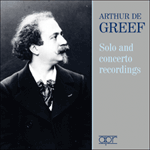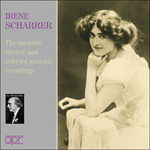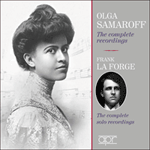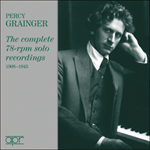The
Fantasie über ungarische Volksmelodien—or ‘Hungarian Fantasy’, as it is commonly known—bears an ineluctable kinship with the
Rapsodie hongroise No XIV, but it was conceived before that work, and diverges from it in many important particulars, the first and foremost amongst which is the tonality: the Fantasy is in E minor, the Rhapsody in F minor. Various reworkings in the Rhapsody proceeded at a different time and pace for those of the Fantasy so, although the Fantasy was the second of the two works to be published, it was the first to achieve its final form. The background material for the piece was the tenth of the
Magyar Dalok and the
Magyar Rapszódia No 21, S242/10 and 21. Liszt took the
Magyar Rapszódia and arranged it for piano and orchestra, adding an extra bar of timpani roll to get things under way, and amplifying the cadenzas in such a way as to recall
Magyar Dal No 10. A new cadenza leads to the main theme of the piece, since identified as the Hungarian folksong
Mohacs Field. This theme is presented three times—from the piano, from the trumpet and then other wind instruments with an agile piano accompaniment, and from the full orchestra. The
Molto adagio which follows derives from the
Magyar Dal No 10, as does the succeeding material. Music in common with the fourteenth Rhapsody but deriving directly in this instance from
Magyar Rapszódia No 21 is the theme marked
Allegretto alla Zingarese, which leads to a reprise in D flat major of
Mohacs Field. After a cadenza based on this theme, but punctuated by fragments of the
Magyar Dal on clarinet and flute, a new theme is presented which will carry the work almost to the end—labelled
Koltoi Csárdás in the
Magyar Rapszódia. At the
Prestissimo coda all the themes are brought together, and in this recording, the curious tradition of slowing the last statements of
Mohacs Field to something less than a quarter of Liszt’s required continuation in tempo prestissimo is deliberately avoided.
from notes by Leslie Howard © 1998
La
Fantasie über ungarische Volksmelodien—plus connue sous le titre de «Fantaisie hongroise»—ressemble indubitablement à la
Rapsodie hongroise noXIV, bien que conçue avant cette œuvre et malgré de nombreux traits particuliers importants qui l’en éloigne, le plus flagrant d’entre eux étant sa tonalité: La Fantaisie est en mi mineur, la Rapsodie en fa mineur. Diverses modifications de la Rapsodie furent entreprises à des époques et à des rythmes différents de ceux de la Fantaisie et, par conséquent, bien que la Fantaisie ait été la deuxième des deux œuvres à être publiée, elle fut la première à adopter sa forme définitive. La matière de fond choisie pour le morceau est la dixième du
Magyar Dalok et la
Magyar Rapszódia no21, S242/10 et 21. Liszt prit la
Magyar Rapszódia et la réarrangea pour piano et orchestre, ajoutant une mesure supplémentaire de roulements de timbales en guise de coup de pouce au morceau et amplifiant les cadences de manière à rappeler le
Magyar Dal no10. Une nouvelle cadence conduit au thème principal du morceau, cadence qui a depuis été identifiée comme étant la chanson folklorique hongroise,
Mohacs Field. Ce thème est représenté à trois reprises—par le piano, par la trompette, puis par d’autres instruments à vent, accompagnés par un piano plein d’agilité et par l’ensemble de l’orchestre. Le
Molto adagio qui suit est dérivé du
Magyar Dal no10, tout comme la suite du morceau. La musique qui fait également partie de la quatorzième Rapsodie, bien que provenant directement cette fois de la
Magyar Rapszódia no21, est le thème présenté comme
Allegretto alla Zingarese, qui conduit à une reprise en ré bémol majeur du
Mohacs Field. Après une cadence basée sur ce thème, bien que ponctuée de fragments du
Magyar Dal à la clarinette et à la flûte, un nouveau thème nous est présenté. Ce thème—intitulé
Koltoi Csárdás dans la
Magyar Rapszódia—portera l’œuvre près de sa fin. La coda
Prestissimo réunit tous les thèmes et, dans cet enregistrement, la tradition étrange qui consiste à ralentir les derniers énoncés du
Mohacs Field jusqu’à environ moins d’un quart de la continuation requise par Liszt en tempo
prestissimo, est délibérément évitée.
extrait des notes rédigées par Leslie Howard © 1998
Français: Jean-Pierre Lichtle
Die
Fantasie über ungarische Volksmelodien—bzw. die „Ungarische Fantasie“, wie sie allgemein genannt wird—weist eine unverkennbare Ähnlichkeit mit der
Rapsodie hongroise Nr. XIV auf, kam jedoch vor diesem Werk zustande und weicht in vielen wichtigen Einzelheiten davon ab, vor allen Dingen in ihrer Tonalität: Die Fantasie steht in e-Moll, die Rhapsodie in f-Moll. Die verschiedenen Bearbeitungen der Rhapsodie gingen in einer anderen Zeit und mit anderer Geschwindigkeit vonstatten als die der Fantasie, so daß die Fantasie, obwohl sie als zweites der beiden Werke veröffentlicht wurde, als erstes ihre endgültige Form erreichte. Hintergrundmaterial für das Stück waren die zehnte der
Magyar-Dalok- und die Nr. 21 der
Magyar-Rapszódia-Melodien, S242/10 und 21. Liszt nahm die
Magyar Rapszódia und arrangierte sie für Klavier und Orchester, indem er mit einem zusätzlichen Takt Paukenwirbel das Geschehen in Gang brachte und die Kadenzen erweiterte, um die
Magyar-Dal-Melodie Nr. 10 anklingen zu lassen. Eine neue Kadenz führt zum Hauptthema des Stücks, das als das ungarische Volkslied
Auf dem Felde von Mohacs identifiziert wurde. Dieses Thema wird dreimal dargeboten—vom Klavier, von der Trompete und dann anderen Blasinstrumenten mit agiler Klavierbegleitung sowie vom gesamten Orchester. Das nachfolgende
Molto adagio geht ebenso wie das anschließende Material auf
Magyar Dal Nr. 10 zurück. Musik, die mit der 14. Rhapsodie übereinstimmt, aber in diesem Fall direkt aus der
Magyar Rapszódia Nr. 21 stammt, ist das Thema mit der Bezeichnung
Allegretto alla Zingarese, das zu einer Reprise von
Auf dem Felde von Mohacs in Des-Dur führt. Im Anschluß an eine Kadenz auf der Grundlage dieses Themas, aber durchsetzt mit Fragmenten des
Magyar Dal, gespielt auf Klarinette und Flöte, wird ein neues Thema vorgetragen, das die Fantasie fast bis ans Ende begleiten wird—es trägt in der
Magyar Rapszódia die Bezeichnung
Koltoi Csárdás. Am Punkt der
Prestissimo-Coda kommen alle Themen zusammen, und in der vorliegenden Einspielung wird die eigentümliche Tradition, die letzten Darbietungen von
Auf dem Felde von Mohacs auf weniger als ein Viertel der von Liszt verlangten
Prestissimo-Fortführung zu reduzieren, bewußt vermieden.
aus dem Begleittext von Leslie Howard © 1998
Deutsch: Anne Steeb/Bernd Müller


 Liszt: Complete Piano Music
Liszt: Complete Piano Music Arthur de Greef - Solo and concerto recordings
Arthur de Greef - Solo and concerto recordings Irene Scharrer - The complete electric and selected acoustic recordings
Irene Scharrer - The complete electric and selected acoustic recordings Olga Samaroff & Frank La Forge - The complete recordings
Olga Samaroff & Frank La Forge - The complete recordings Percy Grainger - The complete 78-rpm solo recordings
Percy Grainger - The complete 78-rpm solo recordings
